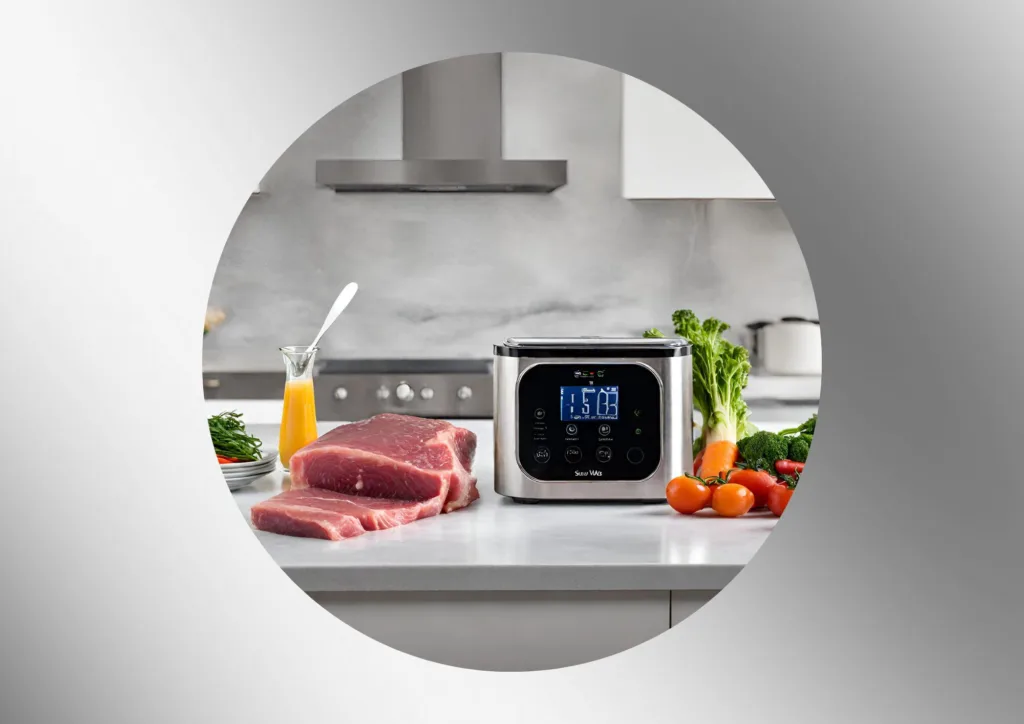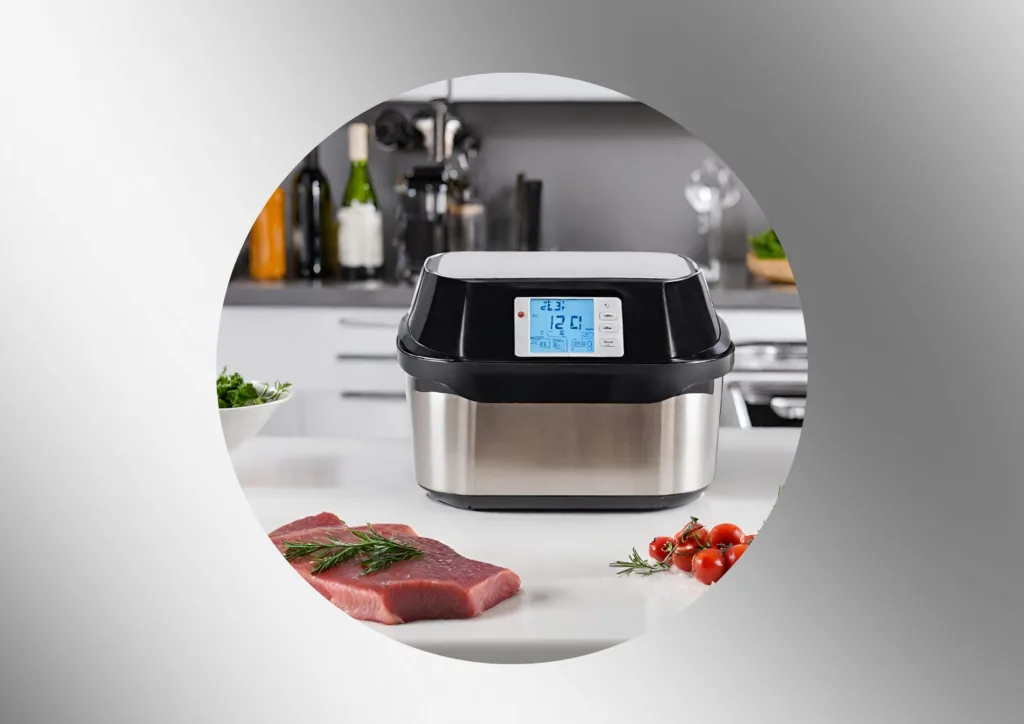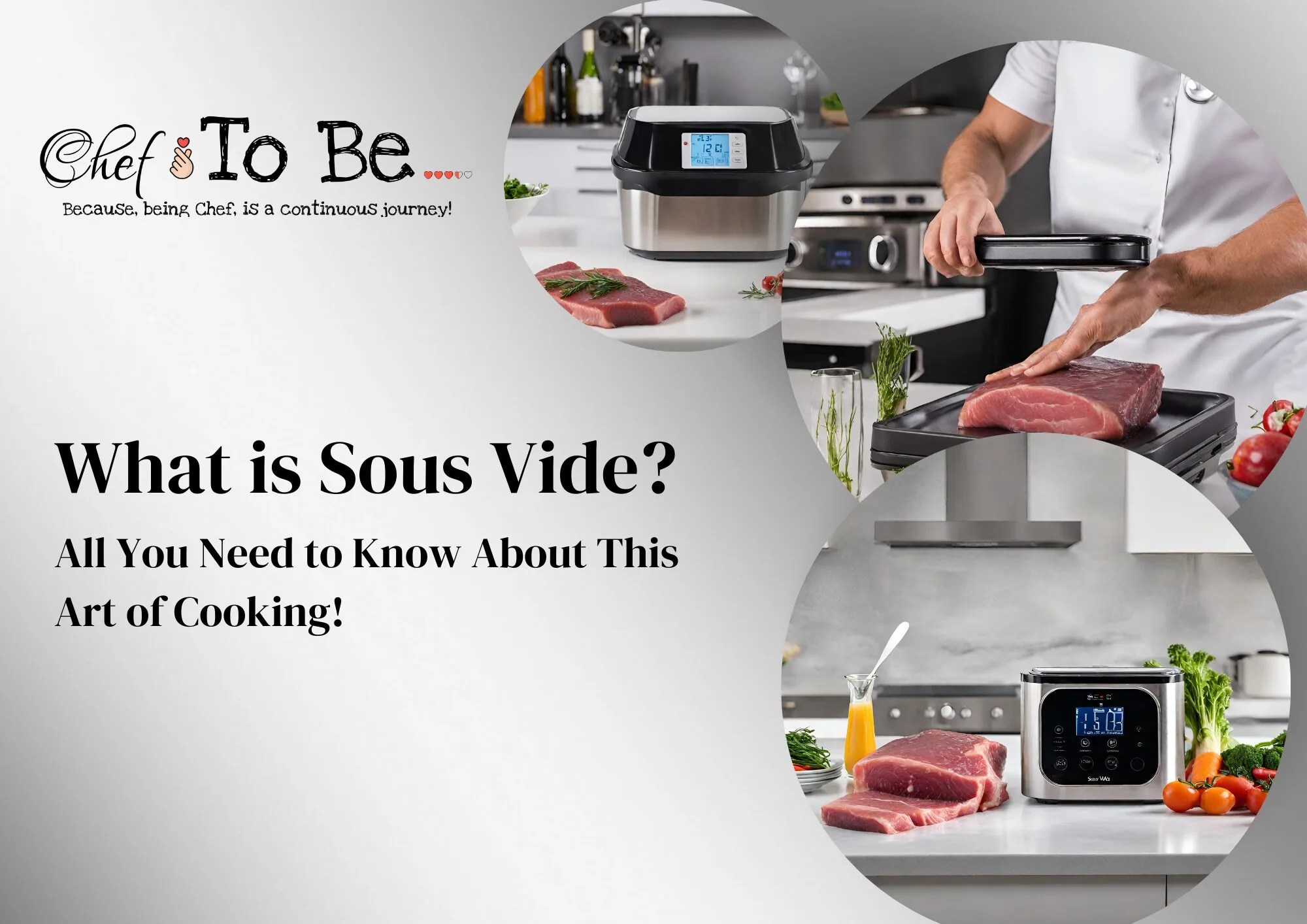What is Sous Vide, after all? I am sure you have heard this numerous times and are aware of the excitement surrounding it. If you’re new to Chef To Be, please check out my most recent dish and provide feedback in the comments section. As this is an in-depth article, I’ve highlighted the key points for discussion. Now, without any delay, let’s delve into the specific topics we’ll be exploring in this post:
- Introduction
- Understanding Sous Vide Cooking:
- What is Sous Vide Cooking?
- What is a Sous Vide Machine?
- How Does Sous Vide Steak Differ?
- Why Choose Sous Vide Chicken Breast?
- Exploring Air Sous Vide
- How is it different from baking?
- Answering Common Questions:
- What is the Point of Sous Vide?
- What is the Sous Vide Method of Cooking?
- Is a Joule Sous Vide Worth Considering?
- What Temperature is Ideal for Sous Vide Cooking?
- Are There Advantages to Sous Vide Cooking?
- Some Recipes using Sous Vide you should try
- List of Sous Vide Machines / Immersion Circulator
- Conclusion
Introduction:
Sous vide cooking, a culinary marvel that translates to “under vacuum” in French, has evolved from a niche cooking technique to a revolutionary method that has redefined the way we approach precision cooking. The origins of sous vide can be traced back to the 1970s, when it gained prominence in the kitchens of French chefs, including Georges Pralus and Bruno Goussault.
The approach emerged as a response to the difficulties cooks found in producing consistent and accurate outcomes using standard cooking methods. Chefs discovered a way to minimize the guesswork associated with traditional cooking by vacuum-sealing items in plastic bags and immersing them in a water bath set at a specific temperature. This unique strategy gave birth to sous vide, changing it from a kitchen experiment to a technology adopted by culinary pioneers.
The Hype of Sous Vide in the Culinary World:
- Precision Redefined: Sous vide allows for unparalleled precision in cooking. Chefs can precisely manage temperatures, ensuring that every bite—whether succulent steak or delicate seafood—is flawless.
- Consistency Across the Board: One of the key attractions of sous vide is its ability to deliver consistent results every time. Furthermore, chefs can replicate the same level of perfection repeatedly, effectively eliminating the variability often associated with traditional cooking methods.
- Retained Flavor and Juiciness: Sous vide is excellent at keeping the natural flavors and fluids of foods. Cooking in a confined atmosphere amplifies flavors, producing a delectable dish loaded with flavor. Furthermore, this rigorous method ensures that each ingredient’s essence is perfectly preserved.
- Versatility Unleashed: From meats and vegetables to desserts, sous vide is a versatile technique that knows no bounds. The precision and control it offers make it applicable to a wide array of ingredients, unleashing creativity in the kitchen.
What Chefs and Home Cooks Are Missing Out On:
For those yet to embrace sous vide, a world of culinary possibilities awaits. The reluctance to adopt this future-oriented technique may stem from misconceptions or hesitations, but the benefits far outweigh any reservations.
- Innovative Culinary Exploration: Sous vide opens the door to innovative culinary exploration, enabling chefs and home cooks to push the boundaries of traditional cooking. Experimenting with textures, flavors, and techniques becomes not just possible but easily achievable.
- Time and Effort Efficiency: Contrary to the belief that sous vide is time-consuming, it can be an efficient method, as compared to traditional methods. While the cooking times are longer, the active preparation time is often minimal, allowing cooks to focus on other tasks or aspects of the meal.
- Consistent Excellence: The consistency offered by sous vide is a game-changer, it delivers excellence consistently, making it an invaluable tool for perfectionists and culinary enthusiasts alike, hence, no more anxieties about overcooking or undercooking.
- Elevated Dining Experience: Whether you’re a professional chef aiming for Michelin-star excellence or a home cook looking to amaze, sous vide greatly improves the dining experience. Additionally, this culinary technique provides precision and consistency, resulting in delicacies that captivate both pros and home cooks. The results speak for themselves, presenting dishes that rival the finest restaurants.
In conclusion, the sous vide hype is not just a trend; it’s a culinary revolution that has fundamentally altered the way we approach cooking. Chefs and home cooks, indeed, stand at the threshold of a future-oriented technique that promises precision, consistency, and an unparalleled culinary journey. The sous vide experience is not just about cooking; it’s about mastering the art of flavor, texture, and innovation in the kitchen, certainly, a time to embrace the future of cooking—welcome to the sous vide revolution.
Understanding Sous Vide Cooking:
– What is Sous Vide Cooking?
Sous vide cooking, which derives from the French phrase “under vacuum,” transforms culinary accuracy. Food is meticulously prepared using this process, which involves placing it in a vacuum-sealed bag to provide an airtight atmosphere. The cooking procedure takes place in a water bath, where the temperature is perfectly controlled to ensure uniformity and excellence. This technology goes beyond traditional culinary constraints, allowing cooks to attain unrivaled precision while improving flavors, textures, and overall dining experiences. Sous vide has developed as a pillar of modern gastronomy, exemplifying the combination of science and artistry in the quest for culinary excellence.
– What is a Sous Vide Machine?
A Sous Vide Machine, also known as an immersion circulator, is a culinary marvel that precisely adjusts water temperature to ensure accurate cooking. Furthermore, precision control ensures culinary brilliance, making it an essential tool for both chefs and home cooks. This equipment exemplifies the spirit of controlled culinary expertise, resulting in an environment where consistency meets accuracy.


By submerging ingredients in a precisely heated water bath, the sous vide equipment takes the cooking experience to new heights. Undoubtedly, its exquisite temperature regulation ushers in a gourmet voyage where perfection reigns supreme, transforming each meal into a masterpiece. In the world of modern gastronomy, the sous vide machine emerges as a vital tool, a maestro orchestrating flavor symphonies through the subtle dance of temperature control.
– How Does Sous Vide Steak Differ?
Sous vide steak defies typical cooking methods with a careful ballet of precision and flavor. The method begins by encapsulating the meat in a sealed bag and immersing it in a water bath. This immersion, together with the controlled temperature, results in a gradual, uniform cook, revealing a juicy interior that defies traditional assumptions. The magic is in getting the desired doneness, creating a gourmet symphony in which every fiber of the steak harmonizes precisely. As the steak emerges from its sous vide bath, it is a faultless canvas, ready for the finishing touch—a beautiful sear that completes this culinary masterpiece with a symphony of textures and flavors.
– Why Choose Sous Vide Chicken Breast?
Opting for sous vide Chicken breast reveals a gourmet adventure where perfection meets poultry. Also, this culinary surprise protects against the common problem of overcooking, guaranteeing that every bite is a luscious delight. The chicken breast is immersed in a sealed bag and cocooned in a water bath. This precise dance of controlled temperature specifically, eliminates the chance of uneven cooking, leaving behind a canvas of tenderness. Sous vide goes beyond the ordinary, transforming chicken breasts into a symphony of aromas. Say goodbye to the dangers of overcooked fowl as sous vide becomes the maestro behind a culinary masterpiece of moist, evenly cooked excellence.
Exploring Air Sous Vide
Air sous vide enters the avant-garde realm of culinary innovation, providing a unique approach to the precision associated with water immersion. This clever approach uses air to create a culinary symphony similar to its aqueous cousin. The strategy appears to violate convention, as it requires establishing an atmosphere in which controlled air temperature becomes the architect of perfection. This revolutionary procedure broadens the culinary field by embracing a different but equally meticulous method of obtaining cooking perfection. Air sous vide emerges as a trailblazer, revealing that in the world of culinary arts, precision knows no limitations, breaking free from old constraints with a breath of invention.
A popular concern is how it differs from baking, given that both processes allow us to manage the temperature.
Certainly, although both air sous vide and baking use temperature control, the main differences are in the cooking environment, technique, and results.
In baking, the principal cooking medium is dry heat from an oven, which creates a convection atmosphere. The heat surrounds the food, causing the Maillard reaction to occur, which results in browning and taste development. While temperature management is important in baking, the emphasis is on the dry heat produced inside the oven.
Air sous vide, on the other hand, cooks primarily using precisely controlled air temperature. This approach does not employ dry heat convection; instead, it uses controlled air to cook food precisely. The air sous vide method is frequently linked with a gentler and more precise approach, which is ideal for getting consistent outcomes in sous vide cooking.
In principle, both approaches entail temperature control, but the cooking medium and the resulting cooking environment are very different. Baking stresses dry heat in an oven, whereas air sous vide focuses on carefully controlled air temperature, providing a distinct approach to precision cooking.
FAQ
Some Recipes using Sous Vide you should try:
- Perfectly Cooked Steak:
- Select your preferred cut, such as ribeye, sirloin, or filet mignon.
- Season with salt, pepper, and herbs.
- Sous vide to the desired doneness (e.g., 130°F / 54°C for medium rare).
- Finish with a brief sear in a hot pan to create a lovely crust.
- Chicken Breast:
- Season chicken breast with herbs, garlic, and lemon.
- Sous vide at 140°F/60°C for 1–4 hours.
- Sear briefly for a golden finish.
- Salmon Fillets:
- Season salmon fillets with dill, lemon, and olive oil.
- Sous vide at 122°F (50°C) for 30 to 45 minutes.
- A fast pan-sear produces crispy skin.
- Soft-Boiled Eggs:
- Sous vide eggs at 167°F / 75°C for 13 to 15 minutes.
- Crack open to reveal a delightfully runny yolk.
- Carrots with Honey Glaze:
- Coat carrots with honey, thyme, and a touch of salt.
- Sous vide at 183°F (84°C) for 45-60 minutes.
- Finish in a hot oven or pan to get a caramelized exterior.
- Asparagus Bundles:
- Combine asparagus spears, butter, garlic, and lemon.
- Sous vide at 185°F (85°C) for 10 to 20 minutes.
- A quick pan-sear for extra flavor.
- Vanilla Creme Brulee Jars:
- Combine egg yolks, sugar, vanilla essence, and cream.
- Pour into jars and cook at 176°F / 80°C for an hour.
- Chill and burn the top to create the typical brulee crust.
- Cheesecake Jars:
- Mix cream cheese, sugar, eggs, and vanilla.
- Sous vide at 176°F (80°C) for 2 hours.
- Top with your favorite fruit compote.
- Root Vegetable Medley:
- Combine carrots, potatoes, and beets with herbs and olive oil.
- Sous vide at 185°F / 85°C for 1–2 hours.
- Roast in the oven to achieve a crispy finish.
List of Sous Vide Machines / Immersion Circulators:
Do you want to test it but don’t have a Sous Machine or an Immersion Circulator? Do not worry! Here’s a list of some goods you should consider purchasing:
- Amazon’s Choice* – Anova Culinary Bluetooth Nano Sous Vide Precision Cooker (12.8 x 2.2 x 4.1 Inches)
- Dash Chef Series Stainless Steel Sous Vide, 8.5 Quart, Temperature Control for Steak/Poultry/Seafood/Vegetables
- Sous Vide Cooker Immersion Circulator, Sous Vide Starter Kit, Sous Vide Pod 1000W, 15 Bags, Pump, Clips, Free Cookbook
- LIPAVI Sous Vide System Model NXC10-UNIR – with C10 Container, N10X Rack and an Universal lid – fits virtually any sous vide machine up to 2.755 inches (70mm) in diameter
- MegaChef MC-1000 Immersion Circulation Precision Sous-Vide Cooker with Digital Touchscreen Display, Black and Silver
- Inkbird ISV-100W Sous Vide Machine Precision Immersion Circulator Cooker Temperature Time and Touch Control Sous-Vide Machine 1000 Watts
- Inkbird Sous Vide Bags Kits, 30PCS BPA Free Reusable Storage Bags for Anova and Joule Sous Vide Cooker – 1 Hand Seal Pump, 5 Sous Vide Bags Clips, 6 Sealing Clips, 2 Replacement Air Valve (44PCS Kits)
- POTANE 6 Pack 11″x20′(3Rolls) and 8″x20′ (3Rolls)Thickened Vacuum Sealer Bags, Smell-Proof, Puncture Prevention, Heavy duty for POTANE, Food Saver, Seal a Meal, Weston. Commercial Grade, BPA Free, Great for Vacuum storage, Meal Prep, or Sous Vide
- 200-count Food Vacuum Sealer Bags 8 x 12 inch, Thick BPA Free Sous Vide Bags Compatible with All Vac Machines, Food Saver, Seal a Meal, Weston, Commercial Grade Quart Precut Meal Prep Storage Bags
- HASTHIP® 100Pcs Vacuum Sealer Bags, 5.9 x 9.8 Inch Vacuum Sealer Bag, Puncture Resistant Sous Vide Bag, Great for Vac Storage, Meal Prep or Sous Vide, BPA Free
DISCLAIMER: All above recommendations are based on avg. customer reviews by Amazon, I am not associated with any kind of endorsement with these brands, Analyze the products according to your own set of parameters before purchasing.
Still not sure about buying? Do not worry!
Discovering sous vide cooking is exciting, and you don’t need any specialized equipment to start. Here are some options for excellent sous vide results:
1. Insulated Containers:
- Use a kitchen cooler or insulated container. These can hold heat well and create a stable atmosphere for sous vide cooking. Simply make sure it’s big enough to hold the food and water bath.
2. Ziploc Bags or Vacuum Seal Bags:
- A vacuum sealer is recommended, although Ziploc bags can also be effective. To remove air from the bag, submerge it in water, leaving only the opening above the surface before sealing.
3. Instant-Read Thermometer:
- This allows you to keep track of the water temperature during the cooking process and adjust for any variations.
4. Clip-on Thermometer:
- Attach a clip-on thermometer to the edge of a pot or container to maintain consistent water temperature.
5. Dutch Oven or Stock Pot:
- Use a robust, heat-resistant pot or Dutch oven for cooking. Make sure it’s large enough to hold the food and keep the water temperature stable.
6. Cheat Sheet or Sous Vide Cookbook:
- Prepare a cheat sheet or sous vide cookbook. These websites contain information on cooking times and temperatures for a variety of meals, allowing you to obtain the best outcomes.
7. Reusable Silicone Bags:
- Opt for reusable silicone bags—they’re eco-friendly and heat-resistant, perfect for sous vide cooking.
8. Oven-Safe Rack or Trivet:
- Consider using an oven-safe rack or trivet to raise your meal and ensure uniform water circulation while cooking.
9. Clip-on Spoon Holder:
- Use a Clip-on Spoon Holder to keep your bags submerged. This guarantees that your food is fully immersed in the water bath, resulting in uniform cooking.
Consider these options to begin your sous vide journey without initially investing in specialized equipment. Experiment, enjoy, and discover the benefits of sous vide with what you have!
Conclusion:
Mastering sous vide cooking expands culinary possibilities and elevates home cooking to new heights. Whether you’re a seasoned chef or a home cook looking to try new techniques, sous vide is a game changer that you should incorporate into your kitchen repertoire. Happy cooking!
If you have any doubts, comment below this post or connect with us through:


